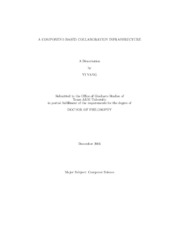| dc.description.abstract | Groupware applications allow geographically distributed users to collaborate
on shared tasks. However, it is widely recognized that groupware applications are
expensive to build due to coordination services and group dynamics, neither of which
is present in single-user applications. Previous collaboration transparency systems
reuse existing single-user applications as a whole for collaborative work, often at
the price of inflexible coordination. Previous collaboration awareness systems, on
the other hand, provide reusable coordination services and multi-user widgets, but
often with two weaknesses: (1) the multi-user widgets provided are special-purpose
and limited in number, while no guidelines are provided for developing multi-user
interface components in general; and (2) they often fail to reach the desired level of flexibility in coordination by tightly binding shared data and coordination services.
In this dissertation, we propose a component-based approach to developing group-
ware applications that addresses the above two problems. To address the first prob-
lem, we propose a shared component model for modeling data and graphic user inter-
face(GUI) components of groupware applications. As a result, the myriad of existing
single-user components can be re-purposed as shared GUI or data components. An
adaptation tool is developed to assist the adaptation process.
To address the second problem, we propose a coordination service framework
which systematically model the interaction between user, data, and coordination
protocols. Due to the clean separation of data and control and the capability to dynamically "glue" them together, the framework provides reusable services such as
data distribution, persistence, and adaptable consistency control. The association
between data and coordination services can be dynamically changed at runtime.
An Evolvable and eXtensible Environment for Collaboration (EXEC) is built to
evaluate the proposed approach. In our experiments, we demonstrate two benefits of
our approach: (1) a group of common groupware features adapted from existing single-
user components are plugged in to extend the functionalities of the environment itself;
and (2)coordination services can be dynamically attached to and detached from these
shared components at different granules to support evolving collaboration needs. | en |


